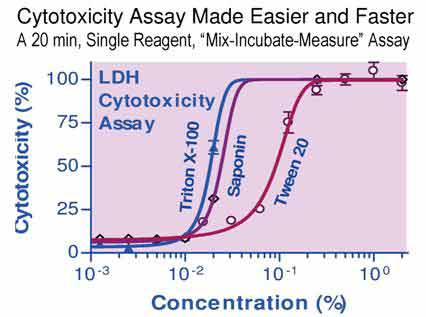QuantiChrom™ LDH Cytotoxicity Assay Kit
Application
- For rapid quantitative determination of cytotoxicity based on lactate dehydrogenase released into the cell culture medium. Evaluation of toxic compounds, toxins, detergents, environmental pollutants and physical treatment on cell lysis.
Key Features
- Safe. Non-radioactive assay (cf. chromium release assay).
- Fast. The whole procedure takes 20 min.
- Robust and amenable to HTS. Single reagent, “mix-incubate-measure” type assay. High-throughput assay in 96-well plates allows the simultaneous processing of tens of thousands of samples per day.
Method
- OD500nm
Samples
- Cell culture
Species
- All
Procedure
- 20 min
Size
- 100 tests
Shelf Life
- 12 months
More Details
Lactate dehydrogenase (LDH) is an oxidoreductase which catalyzes the interconversion of lactate and pyruvate. Cytotoxic compounds often compromise cell membrane integrity by inducing apoptosis or necrosis. LDH is a stable cytosolic enzyme that upon membrane damage is released into the cellular environment. Therefore, LDH is often measured to evaluate the presence of tissue or cell damage. The colorimetric LDH release assay is a simple and robust method to assess cytotoxic effects on cells by measuring the activity of LDH in the cell culture supernatant. The assay is based on the reduction of a tetrazolium salt to a formazan dye.Does this assay kit work for a particular cell line?
Yes, this kit works for all cell lines of any species.
Why is there no standard for this assay?
This assay calculates the percentage of cell death. Therefore it uses the Total Lysis well and the No Treatment Control well (instead of a standard) to calculate the percentage of cell death in your samples.
How long do I need to incubate my test compounds with my cells?
This depends entirely on your test compound and your experiment. The incubation can be as short as 5 minutes to as long as one day. The Triton-X 100 total lysis reagent acts immediately to lyse the cells and can be read immediately if so desired.
What is the best way to store the reagent?
If you will be using the assay constantly every day, then store in the refridgerator. For long term storage, freeze the reagent at -20°C.
When does the assay expire?
The shelf life of the assay is at least one year after receipt at -20°C.
Vergis, J et al (2021). Exploring Galleria mellonella larval model to evaluate antibacterial efficacy of Cecropin A (1-7)- Melittin against multi-drug resistant enteroaggregative Escherichia coli. Pathogens and Disease, ftab010. Assay: LDH Cytotoxicity in galleria mellonella.
Zhou, et al (2019). Retrospective analysis of the efficacy of adjuvant CIK cell therapy in epithelial ovarian cancer patients who received postoperative chemotherapy. OncoImmunology, 8(2), e1528411. Assay: LDH Cytotoxicity in human cells.
Flage, B. (2018). Heme-induced acute lung injury by inflammasome activation in vascular endothelium (Doctoral dissertation, University of Pittsburgh). Assay: Cytotoxicity in human tissues.
To find more recent publications, please click here.
If you or your labs do not have the equipment or scientists necessary to run this assay, BioAssay Systems can perform the service for you.
– Fast turnaround
– Quality data
– Low cost
Please email or call 1-510-782-9988 x 2 to discuss your projects.

$129.00
For bulk quote or custom reagents, please email or call 1-510-782-9988 x 1.
Orders are shipped the same day if placed by 2pm PST
Shipping: RT
Carrier: Fedex
Delivery: 1-2 days (US), 3-6 days (Intl)
Storage: -20°C upon receipt
Related Products
You may also like…
| Name | SKU | Price | Buy |
|---|---|---|---|
| CellQuanti-Blue™ Cell Viability Assay Kit | CQBL-05K |
$219.00 |
|
| CellQuanti-MTT™ Cell Viability Assay Kit | CQMT-500 |
$219.00 |
|
| CellQuanti-Blue™ Cell Viability Assay Kit | CQBL-10K |
$349.00 |
|
| Cytotoxicity Control Reagent (Saponin) | CTTX-050 |
$119.00 |
Why BioAssay Systems
Quality and User-friendly • Expert Technical Support • Competitive Prices • Expansive Catalogue • Trusted Globally
